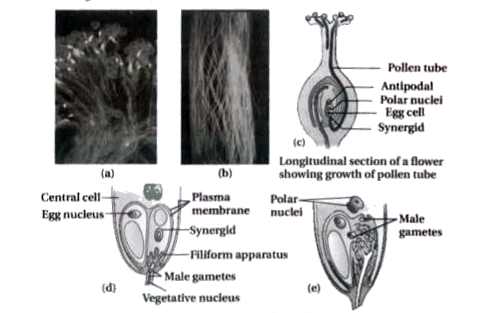Describe pollen-pistil interactionSolution in Gujrati
In nature pollination does not guarantee the transfer of the compatible or right type of pollen. Often pollen of the wrong type, either from other species or from the same plant (it is self incompatible) also land on the stigma.
The pistil has the ability to recognise the pollen, whether it is of the right type or of the wrong type. If pollen is not of the right type the pistil accepts the pollen and promotes post-pollination events that leads to fertilisation. If the pollen is of the wrong type of pistil rejects the pollen by preventing pollen germination.
The ability of the pistil to recognise the pollen followed by its acceptance or rejection is the result of a continuous dialogues between pollen grain and the pistil. This dialogue is mediated by chemical components and protein elements and releasing various water decomposed enzymes present in it. it is only in recent years that botanists have been able to identify someof the pollen and pistil components and the inter actions leading to the recognition, followed by acceptance or rejection. Compatible pollination, the pollen grain germinates on the stigma to produce a pollen tube through one of the germ pores. The contents of the pollen grain move into the pollen tube. Pollen tube grows through the tissues of the stigma and style and reaches the ovary

In some plants pollen grains are sheded at two celled condition (a vegetative cell and a generative cells). In such plants, the generative cell divides and forms the two male gametes during the growth of pollen tube in the stigma. In plants which sheded pollen in three celled condition pollen tubes carry the two male gametes from the beginning. Pollen tube, after reaching the ovary, enters the ovule through the micropyle and then enters one of the synergids through the filiform apparatus. Filiform apparatus present at the micropylar part of the synergids guides the entry of the pollen tube.
All these events from pollen deposition on the stigma until pollen tubes enter the ovule are together referred to as pollen -pistil interaction. The knowledge gained in this area woudl help the plant breeder in manipulating pollen pistil interaction even in incompatible pollinations, to get desired hybrids.
Experiment: You can easily study pollen germination by dusting some pollen from flowers such as peas, chickpea, crotalaria, balsam and vinca on a glass slide containing a drop of sugar solution (about 10 percent). After about 15-30 minutes, observe the slide under the low power lens of the microscope. You are likely to see pollen tubes coming out of the pollen grains.
Topper's Solved these Questions
- BOOK - KUMAR PRAKASHANCHAPTER - SEXUAL REPRODUCTION IN FLOWERING PLANTSEXERCISE - Section -A (Double Fertilization)1videos
SEXUAL REPRODUCTION IN FLOWERING PLANTS
- BOOK - KUMAR PRAKASHANCHAPTER - SEXUAL REPRODUCTION IN FLOWERING PLANTSEXERCISE - Section -A (Post Fertillisation: Structures And Events)5videos
SEXUAL REPRODUCTION IN FLOWERING PLANTS
- BOOK - KUMAR PRAKASHANCHAPTER - SEXUAL REPRODUCTION IN FLOWERING PLANTSEXERCISE - Section -A (Flower-A Fascinating Organ of Angiosperms)3videos
SEXUAL REPRODUCTION IN FLOWERING PLANTS
- BOOK - KUMAR PRAKASHANCHAPTER - REPRODUCTIVE HEALTH EXERCISE - Section - F Multiple Choice Questions (MCQs)102videos
REPRODUCTIVE HEALTH
- BOOK - KUMAR PRAKASHANCHAPTER - STRATEGIES FOR ENHANCEMENT IN FOOD PRODUCTIONEXERCISE - SECTION -F (Multiple Choice Questions (MCQs)) (MCQs Asked In Competition Exam)63videos
STRATEGIES FOR ENHANCEMENT IN FOOD PRODUCTION
Similar Questions
Explain double fertilisation angiosperms
05:22View SolutionWhat is endosperm? Describe types of endosperm
46:30View SolutionMention social, religious and cultural value of the flowers
02:00View SolutionWhich problems arise due to uncontrolled population growth ?
02:39View SolutionPollen-grains of a plant whose 2n = 28 are cultured to get callus by tissue culture method. What would be the number of chromosomes in the cells of the callus?
58:16View SolutionWhat is pollen pistil interaction ?
05:50View SolutionArtificial Hybridisation || Pollen Pistil Interaction || Double Fertilisation
04:35View SolutionThe events in pollen- pistil interaction includes all, except
30:19View SolutionThe knowledge of pollen- pistil interaction helps the plant breeder in
02:47View SolutionArtificial Hybridisation | Pollen Pistil Interaction | Double Fertilisation
41:24View SolutionWhat is pollen pistil interaction ?
08:11View SolutionExplain pollen-pistil interaction in detail.
03:13View SolutionBOARDS SPECIAL|NCERT HIGHLIGHTS#!#POLLEN PISTIL INTERACTION
35:40View SolutionWhat is pollen-Pistil Interaction?
01:20:40View SolutionPollen Pistil Interaction|Double Fertilization
01:40View Solution

